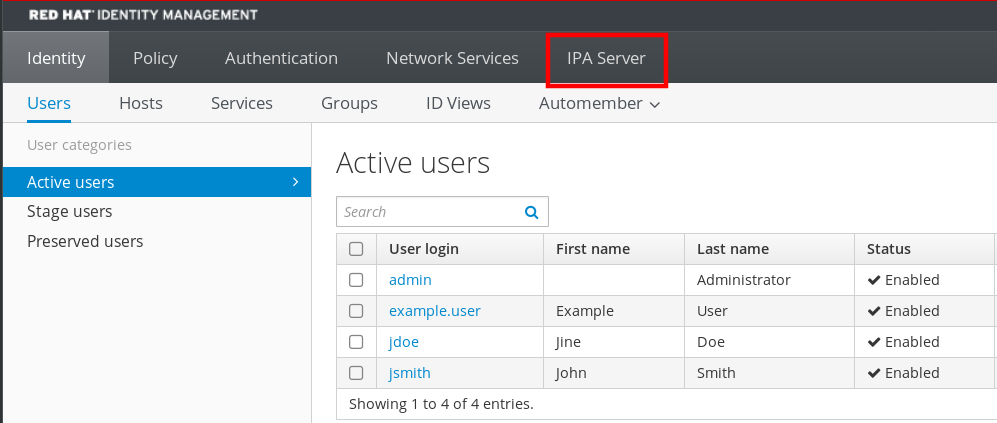Este conteúdo não está disponível no idioma selecionado.
Chapter 4. Searching Identity Management entries from the command line
The following sections describe how to use IPA commands, which helps you to find or show objects.
4.1. Overview of listing IdM entries
You can use the ipa *-find commands to help you to search for particular types of IdM entries.
To list all the find commands, use the following ipa help command:
$ ipa help commands | grep findYou may need to check if a particular user is included in the IdM database. You can then list all users with the following command:
$ ipa user-findTo list user groups whose specified attributes contain a keyword:
$ ipa group-find keyword
For example the ipa group-find admin command lists all groups whose names or descriptions include string admin:
---------------- 3 groups matched ---------------- Group name: admins Description: Account administrators group GID: 427200002 Group name: editors Description: Limited admins who can edit other users GID: 427200002 Group name: trust admins Description: Trusts administrators group
When searching user groups, you can also limit the search results to groups that contain a particular user:
$ ipa group-find --user=user_nameTo search for groups that do not contain a particular user:
$ ipa group-find --no-user=user_name4.2. Showing details for a particular entry
Use the ipa *-show command to display details about a particular IdM entry.
Procedure
To display details about a host named server.example.com:
$ ipa host-show server.example.com Host name: server.example.com Principal name: host/server.example.com@EXAMPLE.COM ...
4.3. Adjusting the search size and time limit
Some queries, such as requesting a list of IdM users, can return a very large number of entries. By tuning these search operations, you can improve the overall server performance when running the ipa *-find commands, such as ipa user-find, and when displaying corresponding lists in the Web UI.
- Search size limit
Defines the maximum number of entries returned for a request sent to the server from a client’s CLI or from a browser accessing the IdM Web UI.
Default: 100 entries.
- Search time limit
Defines the maximum time (in seconds) that the server waits for searches to run. Once the search reaches this limit, the server stops the search and returns the entries discovered in that time.
Default: 2 seconds.
If you set the values to -1, IdM will not apply any limits when searching.
Setting search size or time limits too high can negatively affect server performance.
4.3.1. Adjusting the search size and time limit in the command line
The following procedure describes adjusting search size and time limits in the command line:
- Globally
- For a specific entry
Procedure
To display current search time and size limits in CLI, use the
ipa config-showcommand:$ ipa config-show Search time limit: 2 Search size limit: 100To adjust the limits globally for all queries, use the
ipa config-modcommand and add the--searchrecordslimitand--searchtimelimitoptions. For example:$ ipa config-mod --searchrecordslimit=500 --searchtimelimit=5To temporarily adjust the limits only for a specific query, add the
--sizelimitor--timelimitoptions to the command. For example:$ ipa user-find --sizelimit=200 --timelimit=120
4.3.2. Adjusting the search size and time limit in the Web UI
The following procedure describes adjusting global search size and time limits in the IdM Web UI.
Procedure
- Log in to the IdM Web UI.
Click IPA Server.

- On the IPA Server tab, click Configuration.
Set the required values in the Search Options area.
Default values are:
- Search size limit: 100 entries
- Search time limit: 2 seconds
Click Save at the top of the page.
